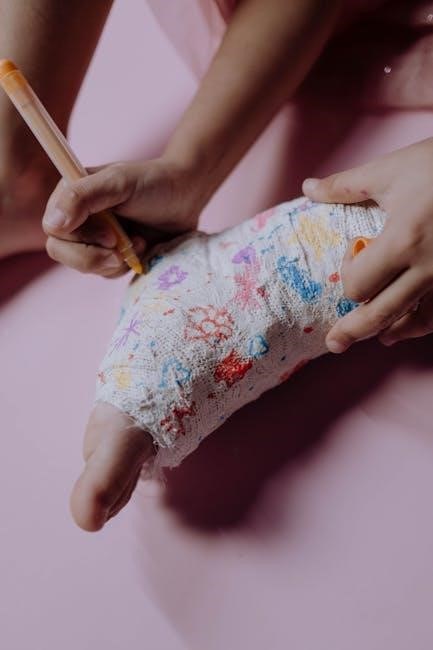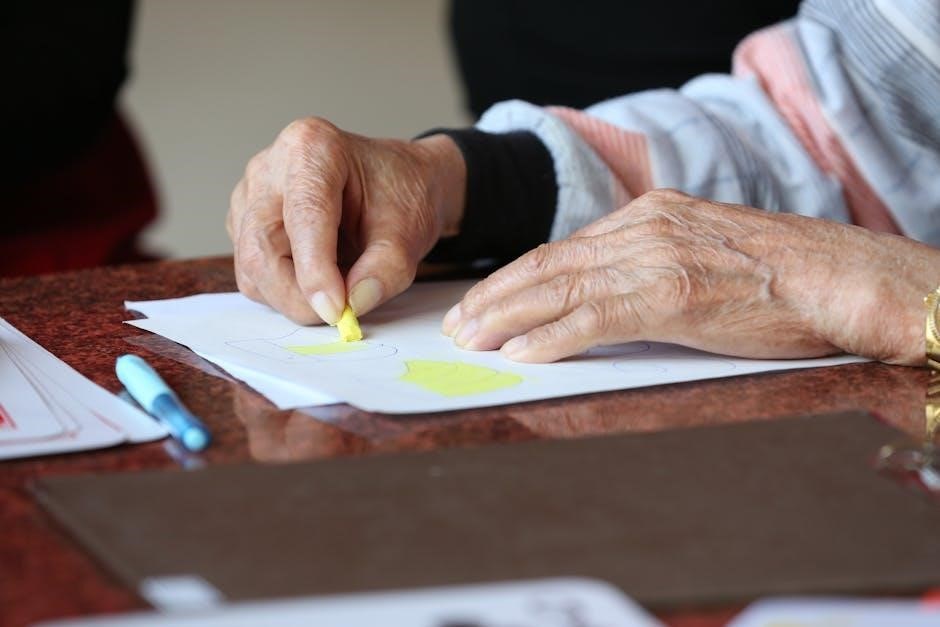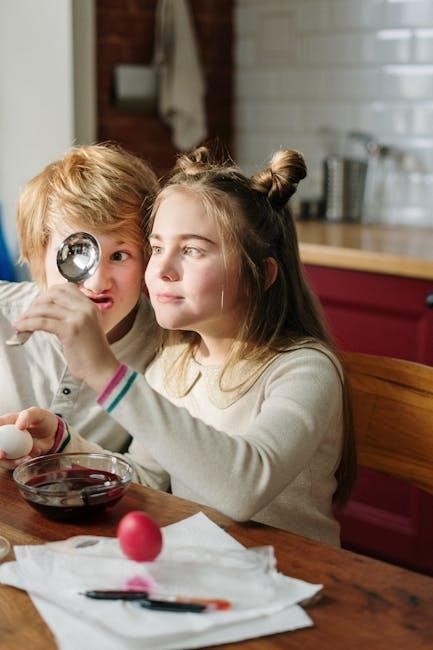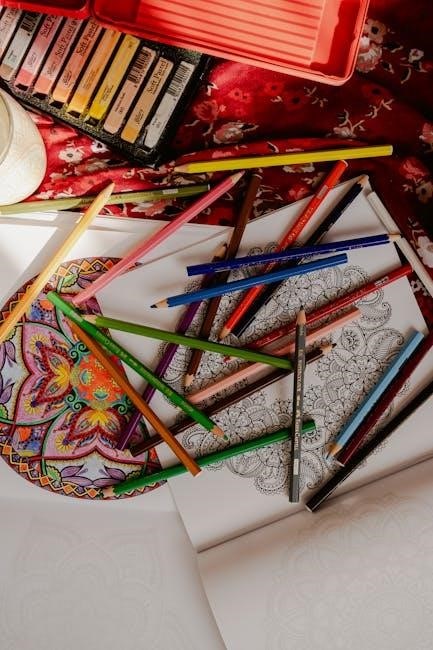Expressive Art Therapy is a therapeutic approach using art-making to enhance well-being. It involves creative expression through various art forms to process emotions and address psychological issues, promoting healing and self-discovery.
Types of Expressive Art Therapy Activities
Expressive Art Therapy includes diverse activities like drawing safe places, creating mini-dioramas, and group murals. These exercises help individuals express emotions and address challenges creatively, fostering healing and growth.
2.1. Drawing a Safe Place
Drawing a safe place is a therapeutic activity where individuals create a visual representation of a space that feels secure and comforting. This exercise helps process emotions and provides a sense of control, especially for those dealing with trauma. Participants use art materials like markers, paints, or colored pencils to depict their safe haven, which could be a real or imaginary location. The process encourages self-reflection and healing by allowing individuals to express feelings they may struggle to verbalize. This activity is particularly effective in trauma recovery, as it offers a creative outlet to revisit and reframe challenging experiences. By focusing on a positive, comforting environment, participants can cultivate emotional resilience and inner peace.
2.2. Creating a Mini-Diorama
Creating a mini-diorama is a therapeutic activity where individuals design a three-dimensional scene within a small container, such as a shoe box. This exercise allows participants to explore emotions and experiences by representing them in a physical space. The diorama can depict a significant life event, a traumatic experience, or an imagined scenario. Using materials like clay, paper, and small objects, individuals can symbolize their feelings and narratives. This activity fosters creativity and provides a visual outlet for processing complex emotions. It also encourages self-reflection and healing by transforming abstract thoughts into tangible representations. The mini-diorama serves as a powerful tool for expressing inner worlds and gaining insight into personal challenges.
2.3. Group Mural Collaboration
Group mural collaboration is a dynamic expressive art therapy activity where participants work together to create a shared visual narrative on a large surface. This collective process fosters teamwork, communication, and emotional expression. Each individual contributes to the mural, adding personal symbols, colors, and imagery, which collectively represent the group’s experiences and themes. The activity encourages trust, unity, and mutual understanding among participants. It also provides a platform for shared storytelling and processing of emotions, particularly in group therapy settings. The mural serves as a visual reflection of the group’s journey, promoting a sense of accomplishment and connection. This collaborative approach mirrors real-life group dynamics, helping participants navigate interpersonal challenges creatively.

The Role of Art Materials and Tools
Art materials and tools in expressive art therapy are essential for facilitating creative expression. Paints, markers, clay, and other tools enable individuals to explore emotions and experiences visually, promoting therapeutic benefits through tactile engagement and self-expression.
3.1. Paints and Markers
Paints and markers are versatile tools in expressive art therapy, offering vibrant ways to express emotions. They allow individuals to explore feelings through color and texture, fostering creativity and self-discovery. These materials encourage spontaneous expression, helping participants process trauma or stress. Markers provide precision, while paints offer fluidity, catering to different artistic preferences. Both tools enable clients to transform inner experiences into visual representations, promoting emotional healing and insight. Their ease of use makes them accessible for all skill levels, ensuring a therapeutic experience focused on personal growth and emotional well-being.
3.2. Clay and Sculpture
Clay and sculpture are powerful tools in expressive art therapy, offering a tactile experience that fosters emotional expression and healing. Working with clay allows individuals to engage physically, providing a therapeutic outlet for stress and trauma. Sculpture enables clients to create three-dimensional representations of their feelings, promoting insight and catharsis. The process encourages exploration of textures, shapes, and forms, helping to externalize internal struggles. This hands-on approach is particularly effective for those who find verbal communication challenging. Sculpture activities, such as creating symbolic figures or abstract forms, can deepen self-awareness and facilitate personal growth. The manipulative nature of clay and sculpture makes them ideal for therapeutic exercises aimed at emotional release and transformation.

Therapeutic Benefits of Expressive Art
Expressive art therapy promotes emotional healing, stress reduction, and self-discovery. It helps individuals process emotions, overcome fears, and address psychological challenges, fostering mental well-being and resilience.
4.1. Emotional Healing
Expressive art therapy fosters emotional healing by providing a safe space for individuals to explore and process complex emotions. Through creative activities like drawing, painting, or sculpting, participants can express feelings that may be difficult to articulate verbally. This process helps in identifying and resolving inner conflicts, reducing emotional pain, and promoting self-awareness. Art-making allows individuals to externalize their emotions, gaining a new perspective on their experiences. Techniques such as mindful exploration and storytelling through art further enhance this therapeutic journey, enabling personal growth and emotional transformation. By channeling emotions into art, individuals can achieve catharsis and develop healthier coping mechanisms, leading to lasting emotional well-being.
4.2. Stress Reduction
Expressive art therapy offers a powerful tool for stress reduction by providing an outlet for creative expression. Engaging in activities like painting, drawing, or sculpting allows individuals to focus on the present moment, distracting from daily stressors. The process of creating art can lower cortisol levels, promoting relaxation and calmness. Techniques such as mindful exploration of art materials encourage awareness of sensory experiences, helping to reduce tension. Additionally, the act of externalizing emotions through art can alleviate emotional burdens, fostering a sense of relief and well-being. Group art activities further enhance stress reduction by building a sense of community and support, helping individuals feel connected and less isolated in their experiences.

Applications in Different Settings
Expressive art therapy is versatile, applied in schools, hospitals, and community centers. It helps individuals address trauma, stress, and emotional challenges in supportive environments, fostering holistic well-being.
5.1. Schools and Education
Expressive art therapy is increasingly used in educational settings to support students’ emotional and psychological well-being. It provides a safe space for children to express feelings, particularly those struggling with verbal communication. Activities like drawing or creating murals encourage self-expression, helping students process emotions related to trauma, anxiety, or stress. Teachers and counselors use these tools to foster creativity and resilience, while also promoting social skills and collaboration. Group art projects, such as collaborative murals, enhance teamwork and unity among students. Additionally, expressive art therapy can be adapted for different age groups and learning needs, making it a versatile tool in schools. It complements traditional education by addressing emotional challenges, creating a supportive environment for overall development and academic success.
Techniques in Expressive Art Therapy
Techniques include mindful exploration, storytelling through art, and spontaneous creation. These methods encourage self-expression, emotional processing, and personal growth, fostering a deeper connection to inner experiences.
6.1. Mindful Exploration
Mindful exploration in expressive art therapy involves using art materials like colored pencils, markers, pastels, and clay to create awareness of sensory stimuli. This technique encourages clients to focus on the present moment, observing textures, colors, and sensations without judgment. By engaging with art materials, individuals can process emotions, stress, and trauma. Mindful exploration can be done in short intervals, fostering spontaneous expression and introspection. This approach helps clients connect with their inner experiences, promoting emotional healing and self-awareness. It is often used as a foundation for deeper therapeutic work, allowing individuals to explore their feelings in a safe and creative environment.
6.2. Storytelling through Art
Storytelling through art is a powerful tool in expressive art therapy, allowing clients to convey emotions and experiences visually. This technique involves creating storyboards or series of images that represent personal narratives. Clients can use various art materials to craft scenes or symbols that reflect their journeys, challenges, or aspirations. This method fosters self-expression and provides a safe space for processing complex emotions. By translating stories into visual form, individuals gain insights into their experiences and develop coping strategies. Storytelling through art is particularly effective in group settings, where shared narratives can foster connection and understanding. It is a versatile approach that bridges creativity with therapeutic healing, making it accessible to both children and adults.

Getting Started with Expressive Art Therapy
Getting started with expressive art therapy involves creating a safe space for self-expression. Experiment with paints, markers, and other materials to explore emotions spontaneously. This approach encourages creativity and healing, suitable for individuals or groups of all skill levels.
7.1. Preparing for Sessions
Preparing for expressive art therapy sessions involves creating a safe and non-judgmental environment. Gather a variety of art materials, such as paints, markers, clay, and collage supplies, to encourage spontaneity and creativity. Ensure the space is comfortable and free from distractions, fostering a sense of security for participants. Encourage individuals to set personal intentions or goals for the session, such as exploring emotions or building self-awareness. Provide a brief introduction to the activity, emphasizing the therapeutic benefits of art-making. Allow time for participants to brainstorm ideas and begin their creative process. This preparation helps individuals feel grounded and ready to engage in meaningful artistic expression.
Expressive Art Therapy offers profound healing benefits, fostering emotional growth and well-being. For further exploration, valuable resources like PDF guides and activity toolkits are available online, providing practical insights and exercises to enhance therapeutic practices.
8.1; PDF Resources
Expressive Art Therapy activities are widely available in downloadable PDF guides, offering structured exercises for emotional healing. These resources include activity lists, prompts, and techniques suitable for both individual and group settings. Many PDFs focus on specific issues like trauma, anxiety, and stress reduction, providing tailored approaches. They often feature practical instructions, examples, and space for reflection, making them accessible for therapists and individuals alike. Some resources blend multiple art forms, while others specialize in mediums like painting or collage. These PDFs are invaluable tools for fostering creativity and therapeutic growth, ensuring users can explore their emotions safely and effectively. They also serve as excellent references for professionals seeking innovative methods to support their clients.